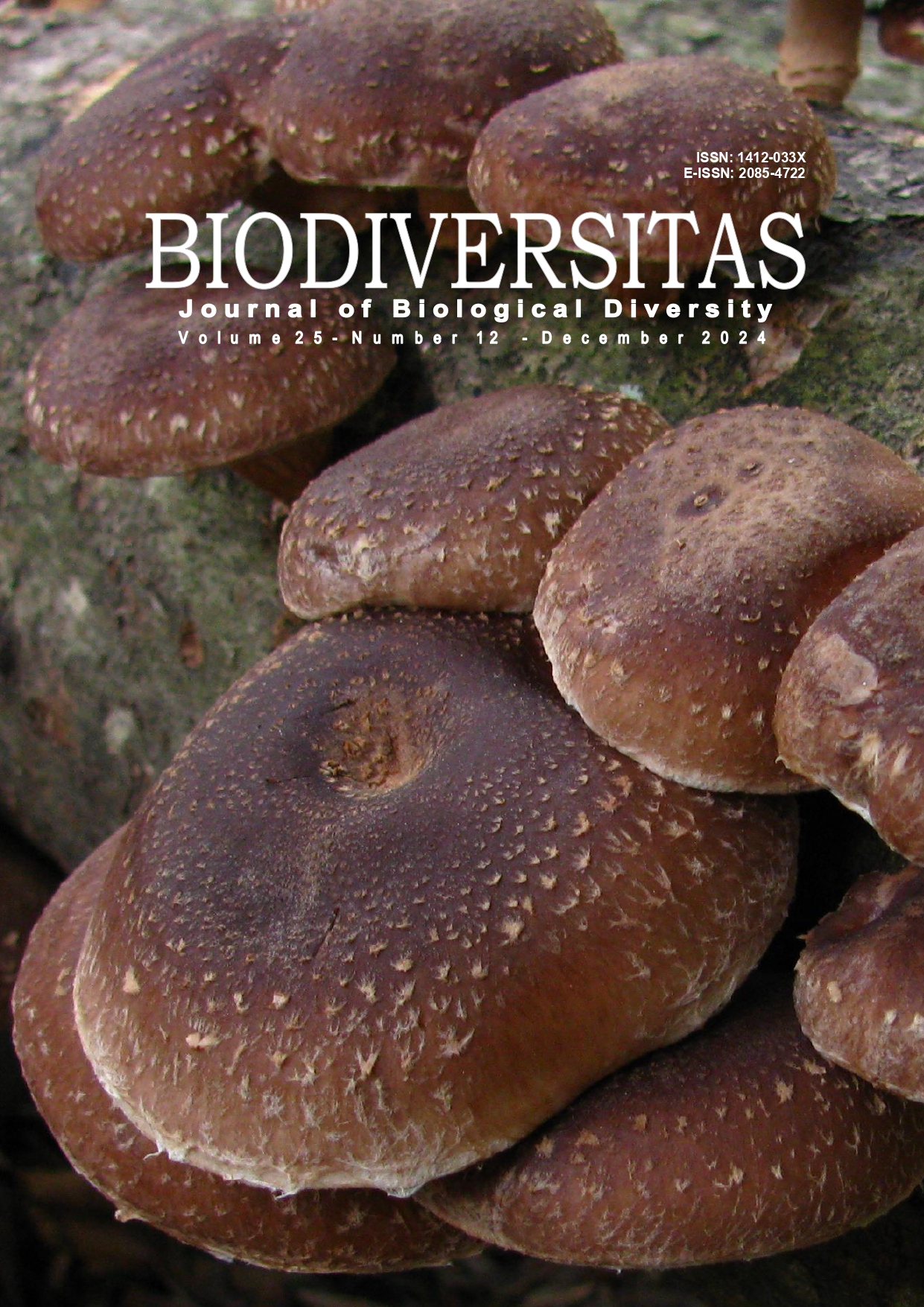Species richness and nest entrance characteristics of stingless bees (Hymenoptera: Apidae: Meliponini) in Ujung Kulon National Park, Banten, Indonesia
##plugins.themes.bootstrap3.article.main##
Abstract
Abstract. Miharja J, Atmowidi T, Priawandiputra W, Perwitasari D, Kahono S. 2024. Species richness and nest entrance characteristics of stingless bees (Hymenoptera: Apidae: Meliponini) in Ujung Kulon National Park, Banten, Indonesia. Biodiversitas 25: 4961-4970. Stingless bees (Hymenoptera, Apidae, Meliponinae) are distributed in tropical and subtropical regions. Ujung Kulon National Park (UKNP), a conservation area of flora and fauna in the western part of Java, was designated by UNESCO in 1992 as a Natural World Heritage site. This study measured the species richness, nesting site, and nest-entrance characteristics of stingless bees in UKNP. Samplings of stingless bees were conducted by road sampling and based on the information from officers of UKNP and the local communities from June to December 2023. Results showed that 163 colonies of stingless bees were found belonging to four species, i,e., Tetragonula laeviceps, Tetragonula fuscobalteata, Heterotrigona itama, and Lepidotrigona terminata. Based on the number of colonies, L. terminata was the most dominant (44%), followed by T. laeviceps (41%), T. fuscobalteata (12%), and H. itama (3%), respectively. The nest of T. laeviceps was found in residential house cavities, bamboo and tree holes, and old and abandoned ant nests, showcasing their adaptability and resourcefulness. Meanwhile, the nest of T. fuscobalteata was found in the rock holes and tree cavities; L. terminata and H. itama nests were found in tree cavities. The unique nest entrance characteristics of each species further highlight their fascinating adaptability. This study showed a new distribution record of stingless bees in Ujung Kulon National Park, Banten, Indonesia.
##plugins.themes.bootstrap3.article.details##
Most read articles by the same author(s)
- ANDI GITA MAULIDYAH INDRASWARI SUHRI, RC HIDAYAT SOESILOHADI, ALI AGUS, SIH KAHONO, The effects of introduction of the Sulawesi Endemic Stingless Bee Tetragonula cf. biroi from Sulawesi to Java on foraging behavior, natural enemies, and their productivity , Biodiversitas Journal of Biological Diversity: Vol. 22 No. 12 (2021)
- ARIF MOHAMMAD SIDDIQ, TRI ATMOWIDI, IBNUL QAYIM, The diversity and distribution of Holothuroidea in shallow waters of Baluran National Park, Indonesia , Biodiversitas Journal of Biological Diversity: Vol. 17 No. 1 (2016)
- ADE EFIN, TRI ATMOWIDI, TARUNI SRI PRAWASTI, Short Communication: Morphological characteristics and morphometric of Stingless Bee (Apidae: Hymenoptera) from Banten Province, Indonesia , Biodiversitas Journal of Biological Diversity: Vol. 20 No. 6 (2019)
- SIH KAHONO, LILIK KUNDAR SETIADI, Diversity and vertical distributions of scarabaeids dungbeetles (Coleoptera: Scarabaeidae) in the tropical mountaineous rainforest of Gede Pangrango National Park, West Java, Indonesia , Biodiversitas Journal of Biological Diversity: Vol. 8 No. 2 (2007)
- WINDRA PRIAWANDIPUTRA, YAMATO TSUJI, KANTHI ARUM WIDAYATI, BAMBANG SURYOBROTO, Dung beetle assemblages in lowland forests of Pangandaran Nature Reserve, West Java, Indonesia , Biodiversitas Journal of Biological Diversity: Vol. 21 No. 2 (2020)
- AYUB WIRABUANA PUTRA, WINDRA PRIAWANDIPUTRA, MAGDALENA LITAAY, TRI ATMOWIDI, Comparison of shallow water soft coral (Octocorallia) diversity and distribution among three islands in Makassar Strait, Indonesia , Biodiversitas Journal of Biological Diversity: Vol. 23 No. 11 (2022)
- DESI NATALIA PASARIBU, AKHMAD RIZALI, HAGUS TARNO, WINDRA PRIAWANDIPUTRA, MIDZON JOHANNIS, DAMAYANTI BUCHORI, Agricultural landscape composition alters ant communities in maize fields more than plant diversity enrichment , Biodiversitas Journal of Biological Diversity: Vol. 25 No. 1 (2024)
- MUHAMMAD FARHAN PUTRA EMIL, WINDRA PRIAWANDIPUTRA, SIH KAHONO, TRI ATMOWIDI, Diversity and nesting ecology of Indo-Malayan stingless bees (Hymenoptera: Apidae) in Aceh Province, Indonesia , Biodiversitas Journal of Biological Diversity: Vol. 25 No. 10 (2024)

